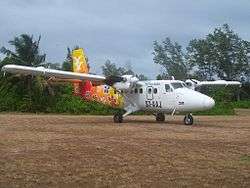Grand Canyon Airlines Flight 6
| Occurrence summary | |
|---|---|
| Date | June 18, 1986 |
| Summary | Mid-air collision |
| Site | Grand Canyon National Park, Arizona |
| Total fatalities | 25 (all) |
| Total survivors | 0 |
| First aircraft | |
 A de Havilland Canada DHC-6 Twin Otter similar to the accident aircraft. | |
| Type | de Havilland Canada DHC-6 Twin Otter |
| Operator | Grand Canyon Airlines |
| Registration | N76GC |
| Flight origin | Grand Canyon National Park Airport |
| Destination | Grand Canyon National Park Airport |
| Passengers | 18 |
| Crew | 2 |
| Fatalities | 20 (all) |
| Survivors | 0 |
| Second aircraft | |
.jpg) A Bell 206 similar to the helicopter involved in the collision | |
| Type | Bell 206 |
| Operator | Helitech |
| Registration | N6TC |
| Flight origin | Tusayan, Arizona |
| Destination | Tusayan, Arizona |
| Passengers | 4 |
| Crew | 1 |
| Fatalities | 5 (all) |
| Survivors | 0 |
Grand Canyon Airlines Flight 6 was a de Havilland Canada DHC-6 Twin Otter that collided with a Bell 206 helicopter call sign Tech 2 over Grand Canyon National Park on June 18, 1986. All 25 passengers and crew on board the two aircraft were killed. It remains the deadliest accident involving a helicopter on United States soil, surpassing the crash of Los Angeles Airways Flight 841 in 1968, which killed 23 people.[1][2]
Collision
On the morning of the accident Grand Canyon Airlines Canyon 6 took off from Grand Canyon National Park Airport at 8:55am for a sightseeing flight over Grand Canyon National Park with two pilots and 18 passengers on board; the pilots were operating their second scenic flight for the day.[3] At 9:13am a Bell 206 call sign Tech 2 operated by Helitech took off from the company's heliport in Tusayan, Arizona for a 30-minute sightseeing flight.[3] At approximately 9:33 at an altitude of approximately 6,500 ft (2,000 m) the Bell 206 and DHC-6 collided, with the helicopter on the left of the Twin Otter and the two aircraft traveling at approximately right angles to each other.[3] The helicopter's main rotor struck the nose landing gear and tail of the Twin Otter.[3] The Bell 206's main rotor was torn off and disintegrated; and the Twin Otter's tail separated; causing both aircraft to crash.[3] All 20 passengers and crew on Canyon 6, and the pilot and four passengers on the Bell 206, were killed in the accident.[3]
Cause
The National Transportation Safety Board found that the crews of the two aircraft failed to 'see and avoid' each other, but could not determine why this occurred due to the lack of recorded flight data (there being no requirement for such recording for the scenic flights that were being operated).[3] The accident investigation also found that the limited number of scenic points of interest in the Grand Canyon concentrated flights over these points, increasing the risk of collision; and recommended that the Federal Aviation Administration (FAA) regulate the separation of flight routes of fixed-wing aircraft and helicopters.[3] Following the accident the FAA imposed changes to the operation of scenic flights over the Grand Canyon.[3]
See also
References
- ↑ "NTSB Identification: DCA86AA028B". National Transportation Safety Board. Retrieved 8 August 2016.
- ↑ Emslie, Robert. "The Tale of Los Angeles Airways and the Skycrane". Hooniverse. Retrieved 8 August 2016.
- 1 2 3 4 5 6 7 8 9 National Transportation Safety Board report of investigation into mid-air collision over Grand Canyon National Park